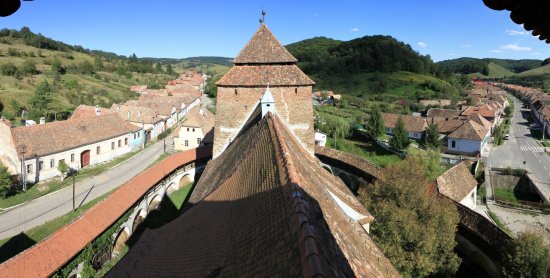 A remote village lost among the sunny hills of southern Transylvania hides a real treasure. It is the church of St. Peter in the village of Valea Viilor (Vine Valley). The story of the village begins in 1263, when the settlement was first documented. The village, colonized by Transylvanian Saxons, gathered serfs and peasants, subjects of the nobleman Apafi, who in 1305 left the village heritage to his son, Gregor. In the fourteenth century, Valea Viilor was a thriving community that decided to demolish the old Romanesque church, built by the early settlers, and instead build a new church in the Gothic style, dedicated to St. Peter.
Traces of the early church were discovered under the floor of the Gothic church vestry. The name of one of the parish priests is known, Gebhard, who was captain of the Saxon Catholic priests from Şeica Dean, rebelled against the new taxes imposed by the Roman Catholic Bishop of Alba Iulia. In 1411, the abbot of the Cluj-Mănăştur monastery claimed ownership over the feud Valea Viilor. In the sixteenth century, villagers in Valea Viilor decided to fortify the church, located right in the centre in a triangular market, to fend off the looming Ottoman peril. As a result, the church, whose defensive structure is based on seven pairs of pillars, built another floor for defence purposes, used by villagers to launch arrows or period firearm projectiles over the enemies.
A remote village lost among the sunny hills of southern Transylvania hides a real treasure. It is the church of St. Peter in the village of Valea Viilor (Vine Valley). The story of the village begins in 1263, when the settlement was first documented. The village, colonized by Transylvanian Saxons, gathered serfs and peasants, subjects of the nobleman Apafi, who in 1305 left the village heritage to his son, Gregor. In the fourteenth century, Valea Viilor was a thriving community that decided to demolish the old Romanesque church, built by the early settlers, and instead build a new church in the Gothic style, dedicated to St. Peter.
Traces of the early church were discovered under the floor of the Gothic church vestry. The name of one of the parish priests is known, Gebhard, who was captain of the Saxon Catholic priests from Şeica Dean, rebelled against the new taxes imposed by the Roman Catholic Bishop of Alba Iulia. In 1411, the abbot of the Cluj-Mănăştur monastery claimed ownership over the feud Valea Viilor. In the sixteenth century, villagers in Valea Viilor decided to fortify the church, located right in the centre in a triangular market, to fend off the looming Ottoman peril. As a result, the church, whose defensive structure is based on seven pairs of pillars, built another floor for defence purposes, used by villagers to launch arrows or period firearm projectiles over the enemies. A chapel dedicated to St. Cyriacus was built near the church. These places of worship were surrounded by a fortress wall, 6-7 metres high. The oval enclosure has four towers, one for each cardinal point, while the entrance to the citadel is guarded by the Western bastion. Access is only possible through a vaulted passage, protected by an iron grill, kept in pristine condition from 1525. The fortification works were completed in 1520, and the first iron grill was replaced five years later. The enceinte wall has buttresses which provide additional strength. The enceinte also has a guard road. The choir and apse walls were partially buried in order to support the weight of an additional tower with a defence role. Ultimately, the church has come to have two towers and a unique architecture.
Medieval Treasures
The inside of the church preserved pews from 1528. The canopy of the pulpit dates from 1746, the altar was created in 1779, while the organ was constructed from 1809. The altar was made by a craftsman in Sighisoara. A museum of Saxon culture opened in the church yard, where tourists can admire numerous ethnographic and historical objects.
Travel info: Distance Bucharest - Valea Viilor is 330 kilometres. Between Cluj-Napoca and Valea Viilor is 143 kilometres.






